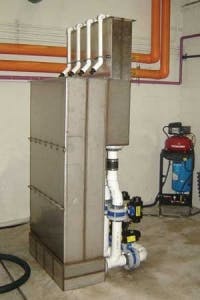PVC Pipe: 21st Century Solution for Clean Water, Sewage By Paul Czachor
PVC (polyvinyl chloride) pipes have been carrying water to communities all over the world since the 1950s. Today, PVC is the most common material used in water systems around the world. It is used extensively in underground municipal systems to carry clean water to homes and sewage to wastewater treatment facilities.
PVC resin is created in an industrial process that combines two naturally occurring and abundant earth resources: natural gas and salt. After the resin is manufactured, it is combined with function additives to make PVC compound, which is extruded into pipe. Color is added to indicate the appropriate use of the pipe: blue for potable water, green or white for sewage, white for irrigation and purple for reclaimed water. The pipes are extruded and cooled in water, then tested to ensure they meet the required standards before being shipped for their intended use.
PVC pipe lengths are joined by bell and spigot or by using fittings also made of PVC. The PVC compound in the pipes and fittings is designed to ensure tensile strength and durability. These traits are essential to municipalities, homeowners and others who count on these systems not to crack under pressure – literally. To demonstrate their durability, PVC pipes and fittings are subjected to quality testing, including crush resistance and impact strength. With a high impact strength and an ability to withstand water hammer and internal hydrostatic pressure, PVC pipes and fittings are well suited for underground applications like water and sewage systems.
The many attributes of PVC pipe make it an ideal choice for municipalities across the United States and Canada that are racing to replace aging and corroded pipes. According to the Uni-Bell PVC Pipe Association, approximately 850 water main breaks occur each day in North America. In addition to wasting precious water and causing countless traffic jams, these water main breaks cost Americans an estimated $50.7 billion a year to repair and replace, according to a congressional study. More information about the number and cost of pipe ruptures can be found at www.watermainbreakclock.com.
In addition to its strength, PVC pipe offers economic and environmental benefits.
First, PVC pipes have a long lifespan which translates into lower replacement and maintenance costs. (Its durability and corrosion resistance also are its greatest environmental attributes.) A recent North American study has conservatively estimated the usable life of PVC pipes to be 110 years while a European study has set that number at 170 years; PVC piping systems that have been excavated after 60 years of use have shown no evidence of adverse wear or degradation. It is also totally recyclable, though little of the PVC pipe currently in service has yet to enter the recycling stream due to its durability.
An additional environmental benefit comes from low weight of PVC pipe. Because pipes are lightweight, less fuel is consumed to transport this product from the manufacturing facility to the job site.
PVC pipes also enhance and preserve quality of life. Once in the ground, the properties of PVC pipe ensure that they will transport clean water for drinking and other uses throughout their lifetime. Because PVC does not react with air and water, PVC pipes always will be free of corrosion and rust.
Similarly, because the inner walls of PVC pipes and fittings are extremely smooth, minimal build-up of materials on the pipe walls occurs. The smoothness of PVC pipes – known as "C value" – results in less friction as water and sewage flow from source to site. Not only does this reduce the energy required to push water and sewage through the pipes, the high C value of PVC enables designers to specify small pipe diameters while achieving the same flow characteristics. The lack of inner wall build-up also results in reduced maintenance and the associated costs.
Finally, in terms of installation, water and sewage systems using PVC pipes and fittings are not complex and typically require few parts; as a result, PVC pipe systems can be installed quickly. Municipalities and contractors also are finding that PVC pipe is an ideal solution when directional drilling is required to bore under roads and rivers to limit the disturbance to local conditions and the environment.
From just about any perspective – cost, sustainability, durability or quality – PVC pipes and fittings are a 21st Century solution that will enable municipalities to safely, affordably and confidently transport clean water and sewage from source to site into the 22nd Century.
About the Author: Paul Czachor is Vice President and General Manager-Pipe Systems at Royal Building Products, a subsidiary of Georgia Gulf Corp.
More WaterWorld Current Issue Articles
More WaterWorld Archives Issue Articles

